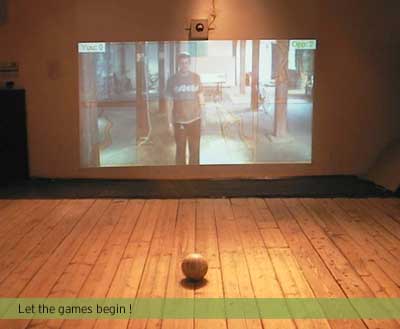Sports over a Distance
Why not combine the advantages of telecommunication technology in bridging
distance, and those of sports in facilitating social introductions and fun?
Asserting that sports and games have these socializing effects, a game environment
can be a valuable augmentation of what current telecollaboration tools try
to accomplish in terms of social interaction. If physical exertion can put
the user in a heightened state of arousal that supports bonding, it makes
sense to leverage the same kind of arousal in a distributed setting. For example,
if strangers meet over a networked environment for the first time, a game
can break the ice, as it provides rules to follow, an activity or experience
to share, and something to talk about.
In order to test our hypothesis, we used these findings to develop a system which allows two players in remote locations to play sports together. As an example of an Exertion Interface, it requires physical effort to play and encourages mastering specific skills. Furthermore, the design aims to make it fun to play and also to support interactions between the players.
Decision on a Ball Sport
We decided to model our system on a proven Exertion Interface: the use of
a ball in sports. Players kick, throw, bat, balance, strike, hurl, pass, dribble
and shoot a ball in a vast range of sports. Games like tennis or volleyball
have the players on two different parts of the field, allowing only the ball
to cross the boundary or net. Based on these examples, we decided to create
a game which keeps distinct parts of the field for each player, supporting
the goal of a functional long-distance game.